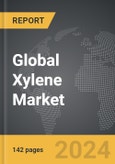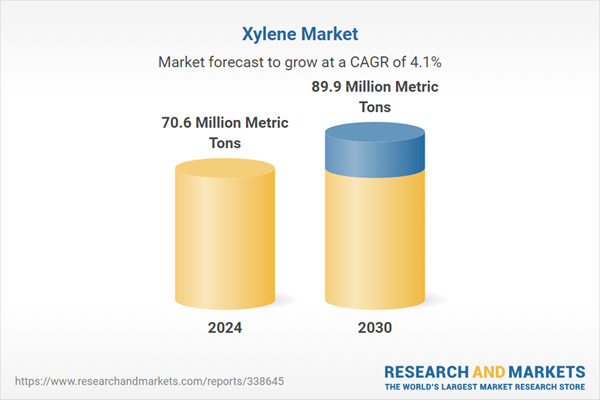Global Xylene Market - Key Trends and Drivers Summarized
Xylene is a colorless, flammable liquid composed of a mixture of three isomers: ortho-xylene, meta-xylene, and para-xylene. Derived primarily from crude oil through catalytic reforming and toluene disproportionation, xylene is a significant petrochemical used extensively as a solvent in various industrial processes. It is particularly valuable in the production of polyester fibers and films, where para-xylene is a key precursor for the synthesis of terephthalic acid and dimethyl terephthalate, both of which are essential in manufacturing polyethylene terephthalate (PET). Xylene's solvent properties make it indispensable in the paint, coatings, and adhesives industries, where it effectively dissolves resins, adhesives, and other chemical compounds, enhancing product performance and application ease. Additionally, xylene finds application in the printing, rubber, and leather industries due to its effective solvency and fast evaporation rate.Technological advancements have significantly impacted the xylene market, enhancing production efficiency and expanding its application scope. Innovations in catalytic reforming and toluene disproportionation processes have increased the yield and purity of xylene, making production more cost-effective and environmentally friendly. The development of advanced separation techniques, such as simulated moving bed (SMB) technology, has improved the efficiency of xylene isomer separation, particularly for para-xylene, which is in high demand. Additionally, the increasing integration of renewable feedstocks and the adoption of sustainable practices in xylene production reflect the industry's response to environmental regulations and the global push towards sustainability. These technological improvements have not only optimized xylene production but also reduced its environmental footprint, aligning with the industry's long-term sustainability goals.
The growth in the xylene market is driven by several factors. The increasing demand for PET in packaging, textiles, and beverage bottles has significantly boosted the need for para-xylene, the primary raw material for PET production. The robust expansion of the automotive and construction industries has fueled the demand for paints, coatings, and adhesives, wherein xylene serves as a critical solvent. Technological advancements in production processes and the development of efficient separation techniques have enhanced the availability and quality of xylene, supporting its widespread industrial application. Additionally, the rising focus on sustainability and the integration of renewable feedstocks in xylene production have driven the market towards more eco-friendly practices. The growing industrial activities in emerging economies, coupled with the continuous investment in infrastructure development, have further propelled the demand for xylene. These factors, combined with ongoing research and development efforts, ensure the sustained growth and diversification of the xylene market, making it a vital component in various industrial applications.
Report Scope
The report analyzes the Xylene market, presented in terms of market value (US$ Thousand). The analysis covers the key segments and geographic regions outlined below.- Segments: Product (Paraxylene, Orthoxylene, Other Products).
- Geographic Regions/Countries:World; United States; Canada; Japan; China; Europe (France; Germany; Italy; United Kingdom; Spain; Russia; and Rest of Europe); Asia-Pacific (Australia; India; South Korea; and Rest of Asia-Pacific); Latin America (Argentina; Brazil; Mexico; and Rest of Latin America); Middle East (Iran; Israel; Saudi Arabia; United Arab Emirates; and Rest of Middle East); and Africa.
Key Insights:
- Market Growth: Understand the significant growth trajectory of the Paraxylene segment, which is expected to reach 70.7 Million Metric Tons by 2030 with a CAGR of a 3.9%. The Orthoxylene segment is also set to grow at 4.8% CAGR over the analysis period.
- Regional Analysis: Gain insights into the U.S. market, valued at 18.8 Million Metric Tons in 2024, and China, forecasted to grow at an impressive 7% CAGR to reach 18.9 Million Metric Tons by 2030. Discover growth trends in other key regions, including Japan, Canada, Germany, and the Asia-Pacific.
Why You Should Buy This Report:
- Detailed Market Analysis: Access a thorough analysis of the Global Xylene Market, covering all major geographic regions and market segments.
- Competitive Insights: Get an overview of the competitive landscape, including the market presence of major players across different geographies.
- Future Trends and Drivers: Understand the key trends and drivers shaping the future of the Global Xylene Market.
- Actionable Insights: Benefit from actionable insights that can help you identify new revenue opportunities and make strategic business decisions.
Key Questions Answered:
- How is the Global Xylene Market expected to evolve by 2030?
- What are the main drivers and restraints affecting the market?
- Which market segments will grow the most over the forecast period?
- How will market shares for different regions and segments change by 2030?
- Who are the leading players in the market, and what are their prospects?
Report Features:
- Comprehensive Market Data: Independent analysis of annual sales and market forecasts in US$ Million from 2024 to 2030.
- In-Depth Regional Analysis: Detailed insights into key markets, including the U.S., China, Japan, Canada, Europe, Asia-Pacific, Latin America, Middle East, and Africa.
- Company Profiles: Coverage of players such as Braskem SA, Exxon Mobil Corporation, Formosa Chemicals & Fibre Corporation, Reliance Industries Ltd., Royal Dutch Shell PLC and more.
- Complimentary Updates: Receive free report updates for one year to keep you informed of the latest market developments.
Some of the 83 companies featured in this Xylene market report include:
- Braskem SA
- Exxon Mobil Corporation
- Formosa Chemicals & Fibre Corporation
- Reliance Industries Ltd.
- Royal Dutch Shell PLC
- US Petrochemical Industries, Inc.
This edition integrates the latest global trade and economic shifts into comprehensive market analysis. Key updates include:
- Tariff and Trade Impact: Insights into global tariff negotiations across 180+ countries, with analysis of supply chain turbulence, sourcing disruptions, and geographic realignment. Special focus on 2025 as a pivotal year for trade tensions, including updated perspectives on the Trump-era tariffs.
- Adjusted Forecasts and Analytics: Revised global and regional market forecasts through 2030, incorporating tariff effects, economic uncertainty, and structural changes in globalization. Includes historical analysis from 2015 to 2023.
- Strategic Market Dynamics: Evaluation of revised market prospects, regional outlooks, and key economic indicators such as population and urbanization trends.
- Innovation & Technology Trends: Latest developments in product and process innovation, emerging technologies, and key industry drivers shaping the competitive landscape.
- Competitive Intelligence: Updated global market share estimates for 2025, competitive positioning of major players (Strong/Active/Niche/Trivial), and refined focus on leading global brands and core players.
- Expert Insight & Commentary: Strategic analysis from economists, trade experts, and domain specialists to contextualize market shifts and identify emerging opportunities.
Table of Contents
Companies Mentioned (Partial List)
A selection of companies mentioned in this report includes, but is not limited to:
- Braskem SA
- Exxon Mobil Corporation
- Formosa Chemicals & Fibre Corporation
- Reliance Industries Ltd.
- Royal Dutch Shell PLC
- US Petrochemical Industries, Inc.
Table Information
| Report Attribute | Details |
|---|---|
| No. of Pages | 224 |
| Published | December 2025 |
| Forecast Period | 2024 - 2030 |
| Estimated Market Value in 2024 | 70.6 Million Metric Tons |
| Forecasted Market Value by 2030 | 89.9 Million Metric Tons |
| Compound Annual Growth Rate | 4.1% |
| Regions Covered | Global |









